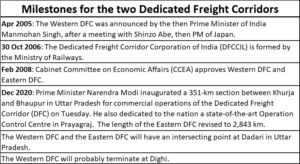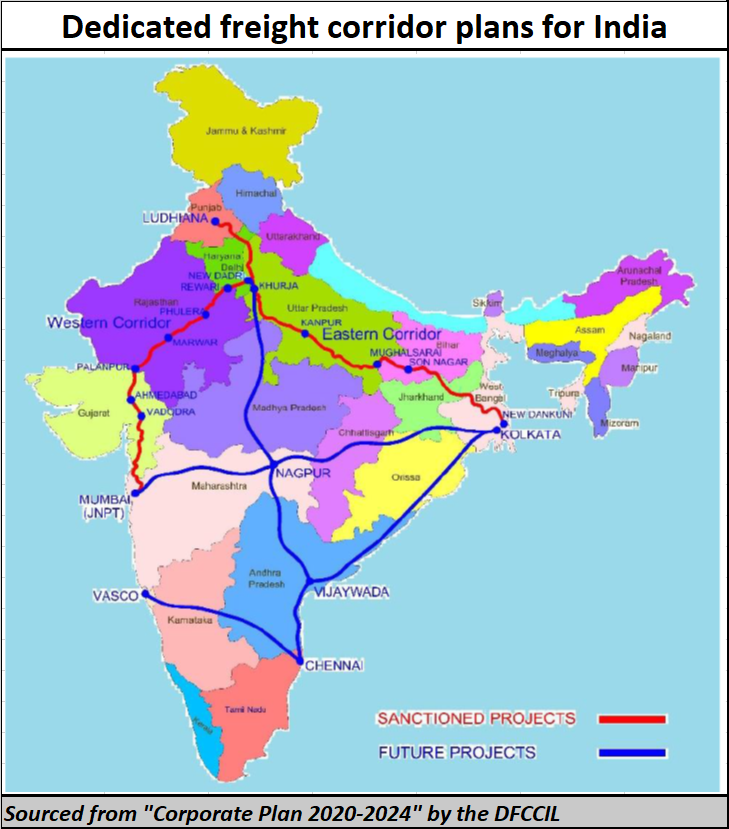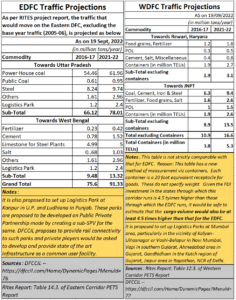The politics and economics behind the two DFCs
RN Bhaskar
By any reckoning, the dedicated freight corridor (DFC) idea was a great concept.
Immensely relevant
As J M Baxi, noted consultant, states (https://www.jmbaxi.com/newsletter/issue-xxvi/dedicated-freight-corridor.html), “The existing trunk routes of Howrah-Delhi on the Eastern Corridor and Mumbai-Delhi on the Western Corridor are highly saturated, with capacity utilization varying in the range of 115 per cent to 150 per cent.”
Given India’s large population, and the limited number of tracks, there is always a tussle between passenger trains and freight trains for the right of way on railway tracks. Inevitably, because passengers are eventually voters, passenger trains get the right of way. That makes cargo trains to move to side tracks till the main track becomes available. Since the number o passenger trains far outnumbers that of freight trains, the former keep the latter waiting for hours. That causes freight movement to get delayed. Effectively, cargo that should have taken 18 hours to travel from Haryana to JNPT, ends up taking a week to ten days. That in turn pushes up interest costs and worsens logistics. The best solution to get over this problem was, therefore, to introduce dedicated freight corridors (DFCs).
 This was recognised by the Manmohan Singh government who discussed this with Shinzo Abe, his counterpart in Japan, In April 2005, both leaders agreed to get the Western Dedicated Freight Corridor (WDFC) going. RITES of the Indian Railways was tasked with the job of doing the surveys and feasibility studies. At that time, the belief was that the project would be up and running by 2017.
This was recognised by the Manmohan Singh government who discussed this with Shinzo Abe, his counterpart in Japan, In April 2005, both leaders agreed to get the Western Dedicated Freight Corridor (WDFC) going. RITES of the Indian Railways was tasked with the job of doing the surveys and feasibility studies. At that time, the belief was that the project would be up and running by 2017.
Christened the Delhi Mumbai Industrial Corridor (DMIC), the project was to build an economic powerhouse around the DFC (https://asiaconverge.com/2011/02/dmic-delhi-mumbai-corridor-will-create-new-best-class-cities/).
By January 2020 (https://asiaconverge.com/2020/05/investments-land-smallest-part-problem/) the 24 townships (including Dholera) were expected to cost around $90 billion. Dholera was touted as the largest SEZ in the world – larger than even Shenzhen – and the entire project that had been taken over by the DMIC was expected to be ready by 2024 (https://dholerasmartcityproject.com/delhi-mumbai-industrial-corridor/). But that was in 2020.
Shift in focus
Suddenly, nobody wanted to talk about the 24 cities (including Dholera). Instead, attention shifted to two other projects:
- The bullet train project spanning Ahmedabad and Mumbai. The foundation stone laying ceremony was held on 14 September 2018 by Japan’s premier Shinzo Abe and the Indian PM Narendra Modi. It was estimated to cost Rs.1.08 lakh crore (one lakh crore = 1 trillion). It is currently estimated to be completed by August 2026 (https://www.livemint.com/news/india/indias-bullet-train-to-run-by-august-2026-ashwini-vaishnaw-11678807757670.html). Significantly, the project cost for the bullet train is much higher than that of the EDFC and WDFC together. In June 2015, the Cabinet Committee on Economic Affairs approved the final cost estimate of Rs, 81,459 crore including land costs. This comprises construction cost of Rs. 73,392 crore (including soft cost of Rs. 19,390 crore) and land cost of Rs. 8067 crore. The cost for the project will be funded by a combination of debt from bilateral/multilateral agencies, equity from Ministry of Railways and Public Private Partnership. The capital structure of DFCCIL will entail a debt equity ratio of 3:1 (https://dfccil.com/Home/DynemicPages?MenuId=78).
- The Eastern DFC, which had been announced in 2008. Its feasibility was always u under question, and the government worked overtime to show that it could be viable. By June 2021, all its funding plans were in place (https://dfccil.com/Home/DynemicPages?MenuId=78). And the Indian prime minister embarked on a series of stage wise inauguration ceremonies, which helped it remain in focus – crucially important for the electorally important Uttar-Pradesh and Bihar constituencies.
There was certainly a lot of fast-tracking of both the Bullet train and the EDFC. The data, which can be gleaned from government documents, shows how this was achieved.
Each segment of the EDFC got commissioned in quick succession. In sharp contrast, the segments that had been identified as early as in 2011, continued to languish.
The 24 cities that were supposed to galvanise industrial growth and employment along with WDFC were forgotten (the full list of the cities can be downloaded from https://asiaconverge.com/wp-content/uploads/2020/05/2020-05-05_DMIC-city-zones-696×913.jpg). All these cities were to be completed by 2018 and were strategically planned on either side of the DFC. This was to ensure that there would be planned growth of industrial centres and housing rather than unplanned growth. None of these seem to matter anymore.
Emphasis was paid on getting all the phases of the EDFC commissioned before the crucial 2024 elections. The chart lists out the way four key segments of the WDFC have been delayed. This is unfortunate, because the states of Maharashtra and Gujarat paid more attention to getting clearances for the Bullet Train Project, which may not bring in as much of economic value, or even employment, and the 24 industrial townships and the WDFC can.
Political imperatives began crafting the direction India’s economic development should take.
The EDFC goes all the way from Ludhiana in Punjab to Dankuni in West Bengal. Dankuni is 25 km away from the Calcutta Port. It is not known if the key linkages between Dankuni and the port have been completed.
The reasons that compelled the government to focus on the EDFC are obvious.
This corridor commences in Punjab, and then runs through Haryana, Uttar Pradesh (UP), Bihar, Jharkhand and then ends at Dankuni in West Bengal. Of these Uttar Pradesh and Bihar are the most populous, and therefore key electoral states. The government needs to show the people living there that it has been keen on their development. These are also among the poorest of states in India (http://www.asiaconverge.com/2020/09/india-plundered-iii-through-tax-devolution-and-transfgers/). UP also faces the ignominy of being host to the highest poverty districts in India according to data provided by the NIC (https://twitter.com/LloydMathias/status/1551006637535928320?t=).
This is in sharp contrast to the WDFC which runs from Rewari in Haryana, Rajasthan, Gujarat and Maharashtra, which are relatively more industrialised states, hence require the DFC more urgently.
But when it comes to politics, it is easier to give the two Hindi speaking states of UP and Bihar a large project with the promise of government jobs, than educating them, and teaching them to become wealth generating states. It is in the interest of politicians to keep them on the dole, so that they will be grateful for the handouts each time elections are held.
That can help explain why the government has not been entirely transparent with the viability of the EDFC when comparing it with the WDFC. The data that the government has provided makes people believe that significant effort has been taken to downplay the economic viability of the WDFC, and enhance the numbers for the EDFC.
This is obvious for three reasons:
The refusal of Japan to fund the politically desirable EDFC, and focus on financing the more viable WDFC.
Data given by the government’s Press Information Bureau (https://pib.gov.in/PressReleasePage.aspx?PRID=1808793), shows that FDI inflows into the Western DFC states is 4.5 times larger than that for the EDFC states. Money flows into areas where there is business potential. In order to enhance that busines potential, the state has to provide better logistics. That has clearly not happened with the WDFC states.
Effectively, the government continues to be in a mood of distributing largesse, without bothering to enhance the revenue mobilisation from wealthier states. Instead of helping the EDFC states grow quickly, it has chosen to hamper the growth of the WDFC states.
The consequences of such decisions will have a buge impact on the country’s per capita income growth. The promotion of the bullet train and the EDFC thus holds out a lesson for all developing countries.








































COMMENTS